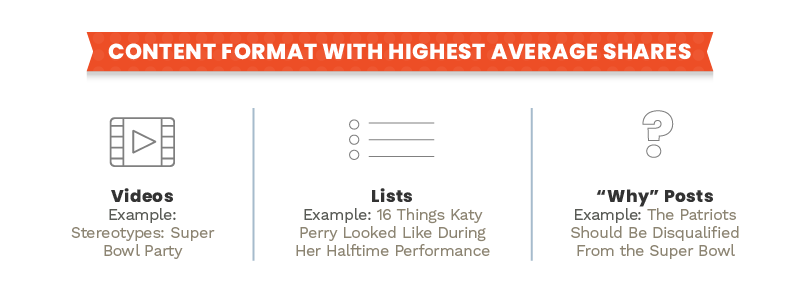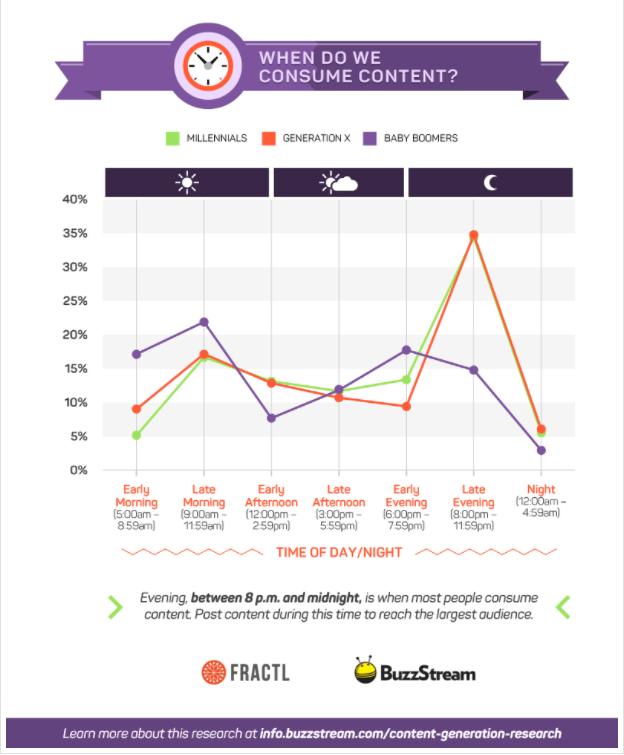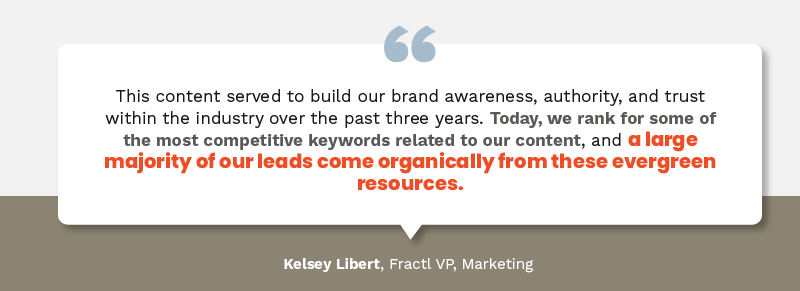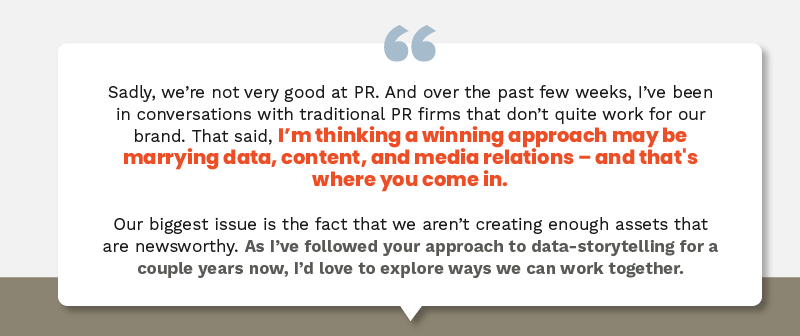You’re amped and ready to break last year’s sales goals, impress your boss, and knock your B2B marketing strategy out of the park. But are you ready?
Sure, you publish blog posts relevant to your company or industry, but there’s a whole lot more you can do with content to bring in leads and convert them to clients. We can help.
Creating high-quality content can be a daunting undertaking, but it doesn’t have to be. We’re going to break down the five ways you can use B2B marketing content to your advantage — from increasing brand awareness to improving your close rate.
Content builds brand awareness.
Spending valuable resources on producing top-notch content and neglecting to promote it properly is like manufacturing automobiles and only selling them in car-less Venice. It simply won’t generate results.
Online content for B2B marketing allows you to find potential customers by increasing your brand awareness and authority – but it only works if:
- The content resonates with your target potential clients
- Your intended audience is exposed to it
Now, let’s dive into the specifics of making both of these criteria happen with one B2B campaign as an example.
Creating the Right Content for Your Audience
What are your target customers’ interests, goals, and problems? If you can’t answer this question, then it’s time to get to know your audience with research. Here are some ideas
- Follow relevant blogs and publishers.
- Run a survey among your email list.
- Read the comments under stories that are related to your industry.
- Peruse the social media accounts of your brand’s followers.
Our B2B marketing case study for Alexa details how we helped the company boost its brand awareness with super relevant content that its target audience (marketers) would find highly valuable. Take, for example, the 2016 Content Calendar.
After thoroughly researching Alexa’s audience, we knew the marketing campaigns we created for them had to include actionable takeaways that left readers fulfilled. The main component of the 2016 Content Calendar campaign (the actual calendar itself) did just that – it was a yearlong plan that marketers could follow to a T for producing and promoting their content.
The calendar would have done somewhat well with marketers, but to raise the authority of our client Alexa, we needed to take it a step further and show that they’re well-versed in what performs well online. On the campaign’s landing page, we sprinkled in more concrete information bites. These included single-event snapshots, examples of content formats that boasted the highest average shares (see image below), and the top social networks to publish these content formats for each month.
The 2016 Content Calendar is just one example of top-notch content that’s geared toward a specific audience. There are several characteristics of high-quality content to check out that can inspire you and help guide the direction of your content.
Once you’ve created the right content for your brand, it’s time to implement the next part of your B2B marketing goals: media outreach.
Getting Press Coverage
Your prospects may find you via search (which is why it’s also important to use SEO tactics with your content), but another way they can spot you is on third-party sites. How does that work? By reaching out to writers and editors at publications that have an audience similar to your brand’s and offering them your high-quality content. If they cover the story, they mention the client and link to them as the source.
We have an entire department dedicated to establishing and building relationships with publishers in every vertical so that we’re ready to hit the ground running once the creation of a content campaign is complete.
If you’re part of a small internal marketing team (or a one-person show) and efficiency is of the essence, don’t fret. Our Tell-All Guide to Digital PR e-book lays it all out for you. If you want an abbreviated version of that, check out our article on how to communicate with writers.
When pitching B2B marketing content to publishers, it’s key to highlight how it will bring value to their readers (otherwise why would they be interested in covering it?). Going back to our Alexa campaign, here is an example of an email pitch we sent:
Over 150 publishers (including niche marketing blogs) featured the campaign, which put Alexa in front of all those target audiences who otherwise would not have seen this content.
With the basics covered, now we’ll give you some tips and ideas for creating high-value B2B marketing content.
Content instills trust in your brand.
By regularly adding content to your site, you help to build trust with potential and existing customers. You can’t slap any ol’ post onto your blog, though. Your content needs to provide real value to your target market and to do that, you must understand them.
One of our clients, BuzzStream (an influencer marketing CRMI), turned to us to help position them as thought leaders in the industry. In one year, we created 19 co-branded campaigns that were published with an ideal cadence in mind. Our B2B marketing case study on our engagement with BuzzStream highlights how we used exclusive data and studies to forge strong relationships with their readers.
For the Generational Content Gap campaign, we deployed a survey to over 1,200 people from three generations and used their answers to reveal trends in online social behavior. The results provided readers with clear takeaways that could guide their social media marketing strategies. The graph below shows the times of day when people consume content.
Publishing on Other Sites
One way to increase the chances of reaching your target audience is to do co-branded studies with reputable brands in your industry. For example, if you clicked on the link in the previous paragraph, you’ll notice it went to Moz, an SEO leader.
When creating joint pieces of content that are published on third-party sites, make sure you have some type of landing page to point back to from those other sites.
PRO TIP: Create a landing page that includes gated upgraded content (e.g., downloadable checklist or template) that prospects must provide their basic information for. Gating is a way to ensure you still get value from it beyond a link (i.e., you’ll earn contacts).
Fractl’s VP of Marketing Kelsey Libert explains how we use the strategy of third-party publication at our agency. “Fractl’s marketing team is focused on spearheading research that we use to further refine our company’s services,” she said. “We began publishing our findings with reputable sites such as Moz and Harvard Business Review, in hopes of demonstrating our in-depth knowledge while also educating prospects.”
How did it turn out?
What Kelsey said about lead generation is a great point, and we’ll explore it next.
Content generates leads.
Successful lead generation content does two things: it attracts new customers’ attention and converts prospects to leads.
To capture the attention of new audiences, your B2B marketing content should target a pain point in your industry and then provide a solution to that problem. This includes:
Content that converts should alleviate anxiety in potential clients. When reading it, your audience should have no doubt that you’re an expert and can produce results for them. This type of B2B marketing content includes:
These two types of content — attracting and converting — work together to produce and nurture the lead. It’s well worth the effort to plan your content marketing calendar with both of these goals in mind.
Content improves close rates.
Similar to converting prospects to leads, educating your target market often makes it easier to close leads. This happens all the time for us at Fractl.
We’ve heard everything from “I will be your fastest close ever; we’ve already decided to go with you,” to “I feel like I should be pitching you to take me on as a client!”
Instead of telling your audience why they should hire your company, you need to show them the value you will provide to them specifically. The more pieces of high-quality B2B marketing content you’ve produced and disseminated, the greater the chance you’ve already addressed their questions, worries, and expectations.
Think about it. Your lead goes into a sales call backed with so much knowledge about the product or service you provide – because they’ve already seen three white papers, watched a webinar, and read your firsthand expertise in a guest post featured on an industry-leading site.
Before your pitch has begun, they trust you and have confidence in the product or service you provide.
A prospect had seen so much of our client work and marketing content online that his main question for us was asking if we were taking on any new clients at that time. Here’s what he said:
As you can see, he was so well-versed in content marketing, he used a lot of our regular terminology (e.g., digital PR, assets, and data-storytelling). When potential customers are educated on your product or services, they also have more realistic expectations for the results they should anticipate.
PRO TIP: As a bonus to the B2B marketing content you create, you can also use it as sales material during in-person pitches or virtual presentations. (We also do this with internal training material, such as process docs and onboarding presentations, that we don’t give out to the public.) Imagine the impression you will make if you can say, “As featured in the Mega Awesome and Authoritative Publication Your Industry Covets.” Pretty cool, right?
Content drives customer loyalty.
Content isn’t just a tool for attracting and converting leads; you can also provide value to existing customers through your content marketing efforts.
Most of the time, a B2B company’s product or service offerings aren’t a one-time deal. As long as you maintain the same or better benefits to your customers (barring unavoidable situations, such as a client’s budget diminishing), your renewals should keep flowing in. However, if your clients are unaware of the value you’re delivering, they have no reason to be loyal to you.
This is where B2B marketing content helps (again).
Telling Customers About Your Hard Work
Sometimes you have to make clients aware of your efforts and expertise. The content you create is a great way to do this.
For example, our usual media outreach process entails providing interested publishers with the various components of a campaign, the methodology we used, and any other information we gathered during the production process.
During outreach for our Alexa campaigns, we found that publishers and editors in the marketing niche wanted guest posts (as opposed to them assigning a writer to cover the content project we sent them). Of course, we were happy to roll with the punches and craft the guest posts in order to win the placements. When you go above and beyond, you can drive customer loyalty by keeping a client in the loop about your willingness to change your strategy as needed to achieve results.
Providing Value to Existing Customers
While your business may not offer content marketing as a service like we do, you can still use content (like guest posts) to showcase your work with a client or audience and cultivate loyalty with them.
B2B content marketing is a long-term strategy that builds your brand and authority over time, not overnight. Sure, you can create an outstanding piece of content that goes viral immediately and gains you exposure, but you have to keep producing high-quality content to show customers that the value you provide them is continuous.
For Movoto, a real estate website, we built audience engagement by continually producing highly interesting campaigns that became resources for their visitors and users. In addition to their real estate services, the content we created for them gave readers a reason to come back to their blog on a regular basis.
In six months, we achieved the following for Movoto:
Upselling Current Customers
In addition to growing customer loyalty, content can help with expanding existing accounts. If your B2B marketing content showcases the full breadth of your products or services – with supporting evidence or examples of how it benefits your current clients – it will make the case to customers for why they should want to expand their work with you.
This means you or your sales team won’t be spending valuable time pitching (and possibly annoying) your clients to purchase other goods or services of yours.
For example, you could use internal data to create a comprehensive report of why something is an issue and then use that data to inform solutions. Here’s how that would look in real life for a content marketing agency like Fractl:
Problem: A company is too conservative to feature creative content that appeals to the masses.
Gather Data: Complete an in-depth review of all your current conservative clients’ engagements and present findings for the number and types of campaigns produced, the breakdown of placements and link types (do-follow, cocitation, etc.), and the number of social shares, page views, and conversions.
Solution: When engaging, long-form content is created for conservative companies, mass appeal can be achieved, but aggressive media outreach must be utilized.
Practical Example: To promote the movie “Racing Extinction,” DIRECTV and The Discovery Channel wanted us to create mass awareness for the film while adhering to their traditional brand values.
On a time crunch to launch this campaign, we worked closely with the brands to ensure our vision aligned with theirs throughout the production process. This included connecting the stats about extinct species to the messages and services offered by DIRECTV and The Discovery Channel (e.g., accessing the documentary via DIRECTV programming).
Before the general awareness campaign – Gone Forever: Extinction Trends Throughout History – was finalized, our digital PR team began their outreach to quickly secure interest. Our strategy worked, resulting in 70 press mentions, which helped to make it the most-watched cable documentary premiere in over three years.
A blog post and case study of our B2B marketing content exhibits how we’ve achieved diverse results for multiple conservative clients. When our existing customers see other types of work we do and how they’re valuable, they reach out to us to try out some of these tactics with their brand. No sales call needed.
Use content as a focus of your B2B marketing strategy.
A large-scale survey among marketers looked at the past year’s success, B2B marketing efforts, and goals for 2017. It offers some findings that can help drive home our tips from above:
- 85 percent attributed their past year’s success to higher-quality and more efficient content creation.
- Takeaway: Publish your top-notch content on a consistent basis.
- 50 percent said their content distribution increased their success.
- Takeaway: Research your target market, understand your potential prospects and know where they frequent online.
- 91 percent of top-performing marketers belong to organizations that have realistic expectations of content marketing.
- Takeaway: Keep at it – content creation should be a long-term strategy.

















